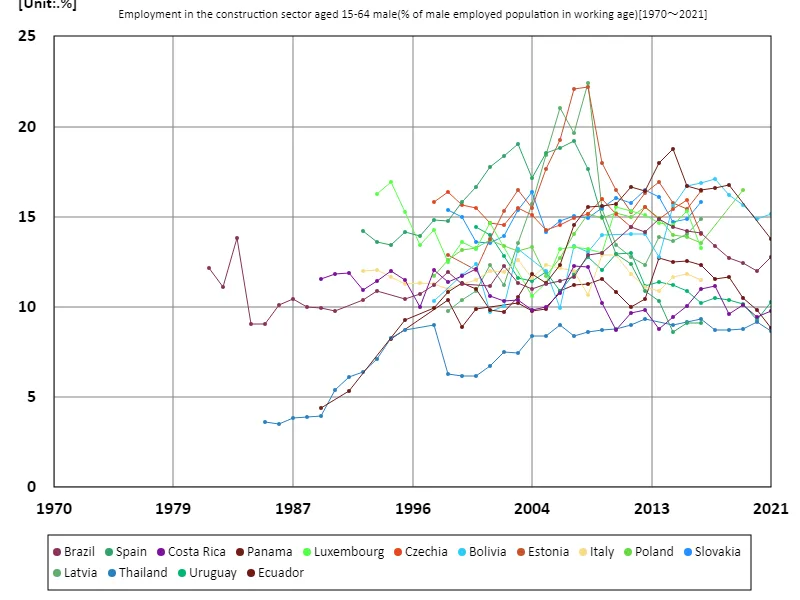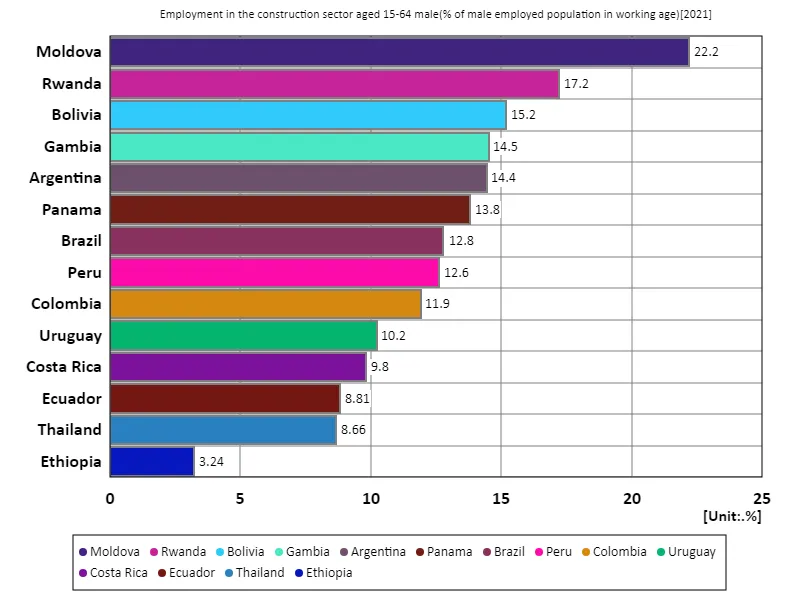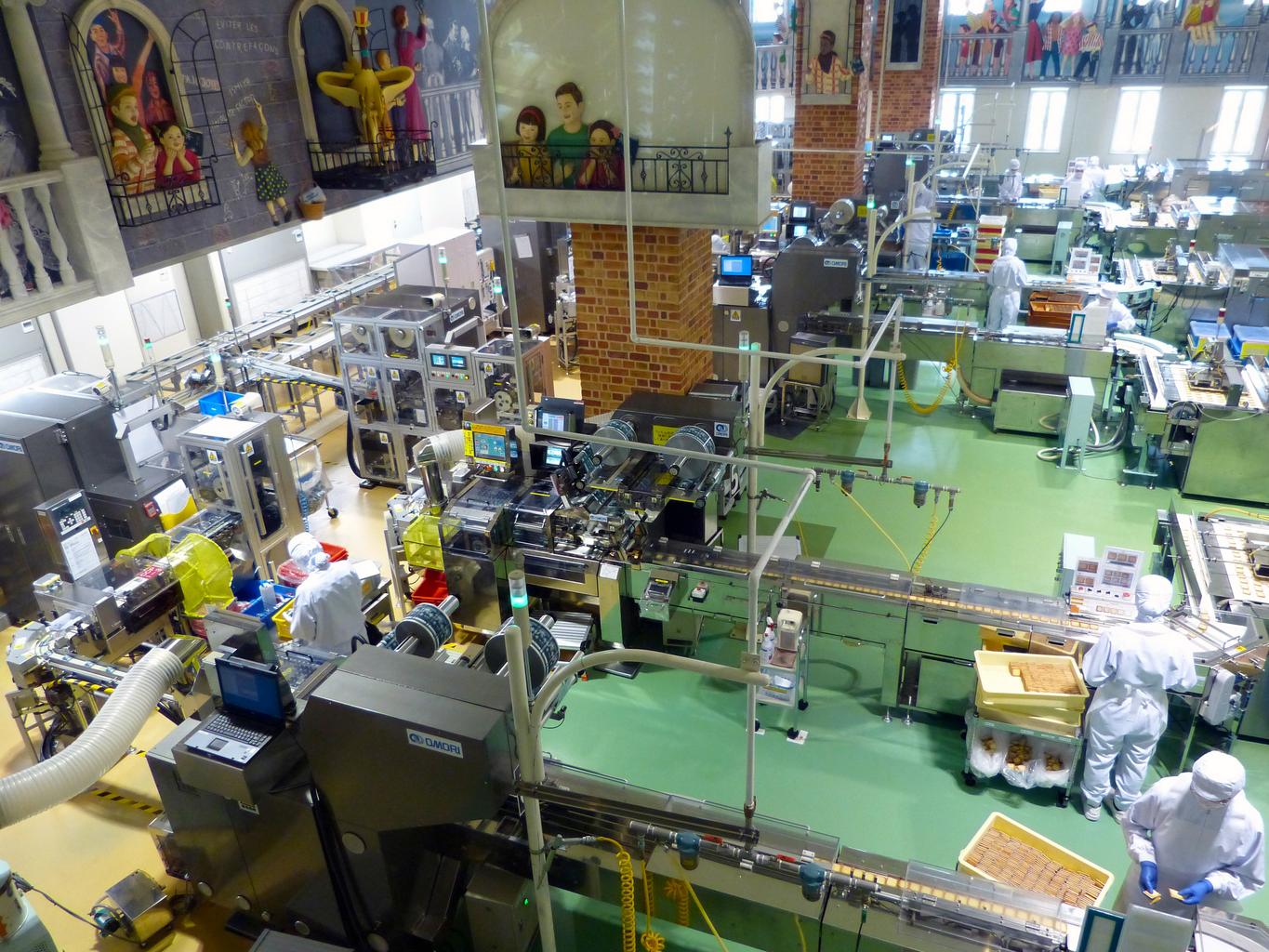- Abstract
- Employment rate in the construction sector for men aged 15-64 (percentage of working-age males in the employed population)
- Employment rate in the construction sector for men aged 15-64 (percentage of working-age male employed population) (Worldwide)
- Employment rate in the construction sector for men aged 15-64 (percentage of working-age male employed population) (Worldwide, latest year)
- Employment rate in the construction sector for men aged 15-64 (percentage of working-age male employed population) (region, latest year)
- Reference
Abstract
While employment rates in the construction sector vary widely depending on specific regions and countries, several factors could explain Bolivia’s high figure of 15.2%. Firstly, Bolivia is experiencing rapid economic growth and is in urgent need of infrastructure development, which is resulting in high demand in the construction industry. In addition, compared to other economic sectors, the construction industry is easy to find work in even with relatively low skills, which makes it easy to attract many workers. Additionally, geography and government policies may be driving construction employment. In contrast, employment rates in the construction industry tend to be relatively low in developed countries, often due to the quality of the workforce and increasing automation. Employment rates in the construction sector vary greatly depending on each country’s economic situation and policies, and understanding these fluctuations allows us to delve deeper into regional economic differences and development directions.
Employment rate in the construction sector for men aged 15-64 (percentage of working-age males in the employed population)
Between 1981 and 2021, the employment rate in the construction sector for men aged 15-64 years shows notable variations across countries. The case of Latvia in particular is noteworthy. In 2008, employment in Latvia’s construction sector reached 22.4%, the highest in the world, but is now 66.3% down from that peak. This significant decline is due to several factors. Firstly, Latvia’s construction industry was heavily affected by the 2008 financial crisis and the subsequent economic crisis. As the economy contracted, demand for construction fell and employment in the construction sector declined. Also contributing to this are structural changes in the labour market and the rise of new job opportunities in sectors other than construction. Additionally, technological advances and increased automation have increased productivity in the construction industry, reducing the labor required. In developed countries in particular, there is a trend towards a decline in employment in the construction sector and an increase in job opportunities in other fields. The example of Latvia shows how economic crises, technological changes and labour market changes can affect construction employment, making it a valuable case study for understanding trends in other countries.


The maximum is 22.4%[2008] of Latvia, and the current value is about 66.3%
Employment rate in the construction sector for men aged 15-64 (percentage of working-age male employed population) (Worldwide)
Between 1981 and 2021, the employment rate in the construction sector for men aged 15-64 has shown significant fluctuations, influenced by economic conditions and technological advances. In 2008, Latvia had the world’s highest construction sector employment rate at 22.4%, but it is now 66.3% down from that peak. This decrease is primarily due to two factors. First, the 2008 financial crisis had a severe impact on the Latvian economy, with the construction industry taking a major hit. With the sudden drop in demand for construction, many construction-related jobs have been lost. Also contributing to this is an unexpected slowdown in growth in the construction industry as the economy recovers. Furthermore, technological innovation and advances in automation have changed the employment structure of the construction industry. The introduction of new technologies has reduced the labor required and increased productivity in the construction industry. This led to a decline in the number of workers and, as a result, employment rates. Overall, the employment rate in the construction industry is sensitive to economic ups and downs and technological changes, making it an indicator that reflects economic trends and changes in the industry in each country.


The maximum is 22.4%[2008] of Latvia, and the current value is about 66.3%
Employment rate in the construction sector for men aged 15-64 (percentage of working-age male employed population) (Worldwide, latest year)
Based on 2021 data, employment rates in the construction sector for men aged 15-64 vary significantly across countries. Moldova has the highest construction sector employment rate at 22.2%, which indicates the importance of the construction industry in the country’s labour market. Compared to the overall average employment rate of 12.5%, Moldova’s figure is significantly higher. Moldova’s high construction employment rate suggests that the country’s infrastructure development and growing demand for housing are driving the construction industry as a significant source of employment compared to other industries. Moldova is also experiencing an ongoing economic growth, with construction activity particularly in urban areas. On the other hand, the total figure of 175% indicates that there are workers with multiple employment statuses and side jobs. For example, the same worker may be involved in multiple construction projects. This reflects the fact that construction is very active in certain regions, with workers having multiple employment. Historically, employment rates in the construction sector have fluctuated depending on a country’s economic situation, its stage of development and the progress of technological innovation. The construction sector is an important source of employment in countries with slow economic growth or where infrastructure development is urgently needed, while other industries tend to be relatively more important in developed countries.


The maximum is 22.2% of Moldova, the average is 12.5%, and the total is 175%
Employment rate in the construction sector for men aged 15-64 (percentage of working-age male employed population) (region, latest year)
According to 2008 data, the overall employment rate in the construction sector in manufacturing for men aged 15-64 was 2.21%, with the Central African Republic recording the highest rate. This indicates that manufacturing and construction are different industries, and that construction employment in manufacturing is relatively small. The low employment rate in the construction sector within the manufacturing industry is due to the fact that manufacturing and construction are different industries and have their respective employment types and labor market characteristics. Manufacturing is usually focused on large factories and production lines, whereas construction is primarily about infrastructure development and building structures. For this reason, there are few departments within manufacturing companies that specialize in construction work, and as a result, the employment rate in the construction sector is low compared to the overall employment rate in the manufacturing industry. Additionally, the Central African Republic recorded the highest employment rate of 2.21%, which may be due to the specific economic and infrastructure development situation in the country. The Central African Republic is a developing country where infrastructure development is progressing, and it is believed that there are a relatively large number of workers engaged in the construction sector within the manufacturing industry. Overall, the employment rate in the construction sector is low within the manufacturing industry, due to differences in industry and structural differences in the labor market. Past trends suggest that the construction industry exists as an independent sector distinct from the manufacturing industry, with clear differences in employment rates within each industry.


The maximum is 2.21% of Central African Republic, the average is 2.21%, and the total is 2.21%



Comments